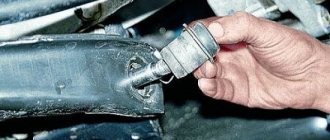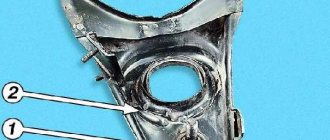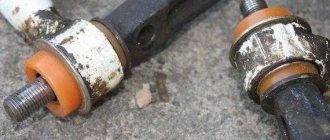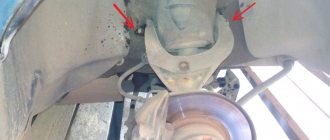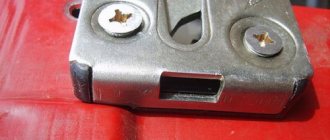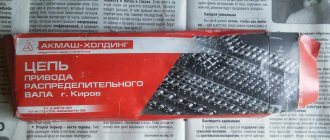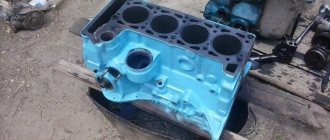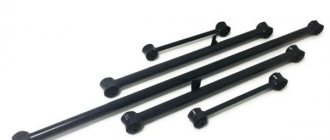We have a VAZ 2105 car, manufactured in 2010, with a mileage of 58 thousand km under repair; it is necessary to replace the reaction rods (rods) on the rear axle suspension. We will show you how to do this procedure yourself; the instructions are also applicable for VAZ 2107, VAZ 2106.
We lift the car. We press the bridge with a hydraulic strut so that the shock absorber is untied and the spring does not fall out. If you will be working on the ground, you can use an additional jack. Nuts 19, unscrew the lower mount of the rear shock absorber:
And another bolt next to it:
Now let's move on to the fastenings of the rods themselves:
We take out the old rod and take a new one, we have rods from the KEDR company, order number MK-01-2919100, new fastening bolts were also purchased for them in advance, their order number is 21010-2919000-86. Before installation, lubricate all fasteners with copper grease so that during further repairs they can be unscrewed without any problems. Install in reverse order.
Then unscrew the top short reaction rod:
Then the front bar:
There are washers on both sides at the front, remove them and replace them with new ones. Using a mounting tool, unscrew the bridge a little to insert the bolt:
After tightening your pants, you can remove the panhard rod:
Fasteners on the other side:
In order to then insert a new bolt into this place, you will again need a mounting tool, which we will use to press out the spring.
Rear suspension of the VAZ-2107 - design and methods for checking serviceability
The design of the rear suspension of the 7 is practically no different from the suspensions of other classic models of the VAZ family. The dependent suspension modification is somewhat outdated and is associated with the presence of a rigid connection between the rear wheels. Of course, a rigid connection has a great advantage - high reliability, as well as ease of maintenance, but there are also some disadvantages. To find out about them, let’s take a closer look at the rear suspension design of the VAZ 2107.
Features of use
The described parts are constantly exposed to severe loads. The vehicle's reaction bars experience loads in both the longitudinal and transverse directions. However, since these knots are part of the undercut, they also work to twist.
Jet thrust is made mainly from steel of more elastic grades. This is necessary to be able to work in very harsh conditions for quite a long time.
The lugs are not part of the design. They are welded separately onto the rod. Welding seams often have a short service life and over time, and even under loads, can collapse. If the seam breaks, they must be replaced. Such spare parts for cars are inexpensive, you can buy them almost anywhere.
Seven rear suspension design
The rear suspension design of the VAZ 2107 is quite simple, which is required by the presence of a rear axle. It is due to the presence of the rear axle that the rear wheels are rigidly connected to each other. The rear axle beam is suspended from the body using reaction rods, of which there are only 5 in the design - four longitudinal rods and one transverse rod.
The main purpose of the longitudinal rods is to prevent and prevent the beam from moving in two directions - forward and backward. Transverse traction is needed in order to prevent the beam from moving when lateral loads occur. You need to know all the suspension parts in order to identify faults and make correct repairs.
This is interesting! To combine the rods with the body part and the beam, special hinges are used, which are made of rubber material and are called silent blocks.
We continue to study the structure of the rear suspension of the seven, and it is worth highlighting another important element - the springs. The lower part of the springs is in contact with the bowl on the bridge beam. To soften contact and prevent squeaks, a thick rubber gasket is placed between the spring and the bowl. The upper part of the springs also rests against the body bowls through an insulating gasket.
Vehicle vibrations are damped using a pair of telescopic shock absorbers. The load that is formed when the vehicle moves on uneven roads is reduced due to the presence of seven three rubber compression seals in the rear suspension design. Two seals are located in the spring structure, and the third is located on the bottom above the rear axle housing. For ease of understanding of all of the above, below is a diagram of the rear suspension of the seven.
- springs;
- telescopic shock absorbers;
- rod or transverse rod;
- axle beam connecting the wheels;
- longitudinal upper rods or rods;
- longitudinal lower rods.
How to check the condition of the rear suspension elements of a VAZ 2107
The opinion that the seven’s suspension has increased strength and wear resistance is not at all a reason for not monitoring its condition. The suspension condition of a car that is operated in off-road conditions or on poorly paved roads (there are still a large number of them left in the post-Soviet countries) especially needs to be checked.
The easiest and most effective way to check the condition of the rear suspension of the seven is a visual inspection. To do this, the car needs to be driven onto an overpass or placed over an inspection hole. Particular attention should be paid to such suspension elements as:
Purpose and operation scheme of the trapezoid
The rod system serves as an intermediary between the steering shaft and the steering knuckles of the front hubs. The task of the mechanism is to synchronously turn the wheels in one direction or another, obeying the rotation of the steering wheel. The trapezoid is located under the engine at the level of the bottom of the car, attached to the body stiffening elements - the lower side members.
The part of the steering mechanism in question consists of 3 main parts:
- the middle link is screwed to two bipods - a pendulum lever and a worm steering gear;
- the right link is attached to the swing arm of the pendulum and the steering knuckle of the front right wheel (in the direction of travel of the car);
- The left rod is connected to the gearbox bipod and the left front hub knuckle.
The method of connecting the swivel brackets to the trapezoid parts is a conical pin, inserted into the counter hole of the bipod and secured with a nut. The pendulum arm and gearbox are rigidly attached to the side members with long bolts.
The middle link is a hollow metal rod with two hinges. Two side rods are prefabricated elements consisting of 2 tips - long and short. The parts are connected to each other by a threaded clamp, tightened with two bolts.
How does a trapezoid work:
- The driver turns the steering wheel, rotating the shaft and shank of the gearbox. The worm mechanism transmits fewer revolutions to the bipod, but increases torque (force).
- The bipod begins to turn in the right direction, dragging the left and middle rods with it. The latter transmits force to the right rod through the pendulum bracket.
- All 3 elements move to one side, causing the front wheels to turn synchronously.
- The pendulum arm, mounted on the second spar, acts as an additional hinged suspension for the system. In older versions of pendulums, the bipod rotates on a bushing, in new elements - on a rolling bearing.
- Ball pins at the ends of all rods allow the trapezoid to move in one horizontal plane, regardless of the compression of the front suspension springs.
Increasing torque with a worm gear makes it possible to do without hydraulic and electric power steering. On the other hand, the driver physically feels problems with the chassis - as soon as the ball joint or rod end becomes sour, it becomes much more difficult to rotate the steering wheel.
How to change jet rods on a VAZ 2107 with your own hands
If the car remains stable while driving, it will be safe. This rule is equally relevant for passenger cars and trucks. The VAZ 2107 was no exception. The car could never boast of high handling. That's why engineers developed a system with jet thrusts. But even such elements can fail, raising questions about independent replacement.
- Purpose of thrust rods on the VAZ 2107
- Jet thrust malfunctions and possible consequences
- Checking the condition of the jet rods on the VAZ 2107
- Test sequence
- Video checking jet rods on a VAZ 2107
- Selection of thrust rods
- Replacing jet rods on a VAZ 2107
- Removing jet rods
- Repair and installation of jet rods
- Video of changing jet engines on a VAZ 2107
- Replacing bushings and silent blocks on VAZ 2107 rods
- Sequencing
- Conclusion
Purpose of thrust rods on the VAZ 2107
Tie rods provide protection against swaying and loss of control on the road, during sharp turns and obstacles. Even earlier versions of the car had similar problems. But inside the cars there were only ordinary springs; no one knew anything about the system with rods.
It is for this reason that the vehicle caused many problems when driving. Only over time the suspension was modified. A system was installed with several long rods. This part carried the main load.
Classic VAZ 2107 cars and other models contain the following version of the torque rod kit:
- Long.
- Short.
- A large transverse one, which also serves as the basis for the entire system.
Installation location - near the car axle located at the rear. The system is visible only from the inspection hole, where repair work is usually carried out if the reaction rods are replaced.
From the history of the rocket rod
As technology advanced in the automotive industry, engineers constantly worked to increase the speed of cars. Even before the outbreak of World War II, the developers came to the conclusion that the then low-tech and simple rear suspension, where a spring was used as an elastic part, was also a stabilizer.
So, when driving at high speeds, there were reasons that significantly influenced the controllability. This is body swaying, various rolls. If you move along the road at low speeds, this will not cause any discomfort or negativity; these forces will not be felt. However, if you increase the speed, such movement can cost the driver of the car his life.
To put it another way, automakers began to think and conduct tests in order to somehow remove the impact on the car of forces that could overturn it. For this, developers and engineers came up with a special system of levers, which laid the foundation for the creation of independent suspensions. The developments did not stop there. To ensure stability of the car body, jet thrust was created.
Jet thrust malfunctions and possible consequences
If the load causes the axle to sway or shift, the impact will be taken by the jet thrust. The appearance of defects in parts leads to a deterioration in the overall behavior of transport. Damaged parts need to be replaced as quickly as possible.
The following factors often cause breakdowns:
- Exposure to chemicals from road compounds in winter;
- Impact of torsional loads. Occurs more often when colliding with obstacles. Only reducing the speed before these elements reduces the risks;
- Static loads. This factor is only reduced by the absence of overloads; it is impossible to completely get rid of it when operating rods on a VAZ 2107.
It is important to detect deformation, chips and cracks in a timely manner, for which periodic inspection of the entire system is organized. Welding seams and silent blocks are weak points that receive the most attention during inspections.
Silent blocks of any type are rubber, so they wear out faster than metal parts. Due to their wear, backlashes appear, becoming an obstacle to the stabilizing function. Welded joints, when they break, also lead to unpleasant consequences. It is recommended to remove them as quickly as possible.
With broken parts, driving is worse. Added to this is the unstable behavior of the body when defects appear in the jet rods.
Rear linkages
To prevent longitudinal vibrations from affecting the bridge, it is held in place by longitudinal thrust. This design is distinguished by the fact that both ends are secured through silent blocks to the mounts on the bridge and on the body. The design of this mechanism can be seen in the photo below.
Often such a cross bar can be of considerable length. This is due to the fact that the bridge can move either down or up, and the travel is limited only by the travel of the shock absorber, which dampens vibrations. In order to ensure mobility, the rod is made according to the principle of a lever. Even if the bridge moves through the entire stroke of the shock absorber, the silent block will not twist.
Checking the condition of the jet rods on the VAZ 2107
100 thousand kilometers - new parts from the car are enough for this period, according to existing instructions. But the actual service life rarely exceeds 80 thousand kilometers, given real conditions.
The same instructions say that it is recommended to organize checks every 20 thousand kilometers. And here the experts recommend reducing the period by 5-10 thousand km to make it easier to avoid unpleasant surprises. You can’t do without an inspection hole and a mounting blade; this is the only way the jet thrust can be opened for viewing and other actions.
Test sequence
The steps are not that complicated:
- Installation of transport on a viewing hole or on an overpass;
- Mounting blades are inserted behind the traction eyes;
- The spatula rests against the jet thrust bracket. An attempt is made to shift the part, together with the silent block. If the action is successful, it means the part is worn out and needs to be replaced;
- Repeating a similar procedure with each silent block. If it moves sideways by a few mm, the need for replacement is obvious.
The rods themselves, along with the eyes, are also checked for wear. If any defects are detected, in this case the bushings and other parts are replaced.
Video checking jet rods on a VAZ 2107
Troubleshooting
As the car moves, the ball pins rotate in different planes and gradually wear out the crackers, which causes backlash. The following signs indicate critical wear of a tip (or several):
- a distinct dull tapping sound when driving over any uneven surfaces;
- vibration from the play of the ball pins is transmitted to the steering wheel;
- on a flat section of the road the car spontaneously leaves the straight path;
- The rotation of the steering wheel is difficult, and a creaking sound is heard from below.
When a lot of force is required to turn the steering wheel, the worn tip must be replaced immediately. The symptom indicates that the ball pin is jammed inside the housing. If measures are not taken in time, the hinge may jump out of its socket and the car will become uncontrollable.
A similar story happened to my relative. When there was literally half a kilometer left to drive to the garage, the right steering tip on the “seven” broke off. The driver showed ingenuity: he tied the end of the dropped rod to the suspension arm, leveled the wheel with his hands and slowly continued driving. When it was necessary to turn, he stopped, got out of the car and manually adjusted the wheel in the right direction. The 500 m long path was covered in 40 minutes (including the entrance to the garage).
Steering rods of Zhiguli cars become unusable for a number of reasons:
- Natural wear and tear. Play and knocking appear at 20-30 thousand km, depending on conditions and driving style.
- Operation with torn hinge boots. Water flows into the unit through the holes, dust and sand penetrate. Corrosion and abrasive effects quickly destroy the ball pin.
- Lack of lubrication leads to increased friction and accelerated wear. The presence of lubricant must be checked before installing the part on the car.
- Bending of the rod due to impact with a stone or other obstacle. If the outcome is successful, the element can be removed and leveled by heating it with a burner.
When the production of all tips reaches a critical limit, the front wheels have large free play in the horizontal plane. To drive straight, the driver has to “catch” the car along the entire road. How to diagnose wear on steering rods and not confuse them with suspension faults:
- Place the car on a viewing ditch or overpass and apply the handbrake.
- Go down into the hole and carefully inspect the trapezoid, especially after hitting the bottom.
- Grab the shaft near the tip with your hand and rock it up and down. If you feel free movement, replace the worn element. Repeat the operation on all hinges.
The method of developing traction during diagnosis is of great importance. There is no point in turning the lever around its own axis - this is its normal operating stroke. If the test shows a small tight play, the hinge is considered to be in good condition - the internal spring is triggered.
Replacing jet rods on a VAZ 2107
It is necessary to prepare a kit with tools and consumables in advance. Their main list is as follows:
- Hammer;
- Set with open-end wrenches. The reinforced double type parts are sometimes difficult to remove without additional tools;
- Blades for installation;
- WD-40 – this composition removes rust;
- A set with new reaction rods, including a transverse one.
When everything is ready, they begin the work itself.
Removing jet rods
Removing old parts is the first step where work begins.
The process involves the following sequence:
- A wire brush is used to remove rust and dirt from threaded connections. Then WD-40 is used for processing. You will need to wait some time before the work can continue. The instructions are also relevant for the classic model.
- Completely unscrew the nut, due to which the washer is held on the free side. This process is difficult, it is better to take a long wrench and, if necessary, re-treat the surface with WD-40.
- Dismantling the bolt and nut, moving to the other side. The rear parts are dismantled in almost the same way.
- Unscrewing the nut from the lower shock absorber mounting. The bolt with the spacer sleeve is also removed.
- Shift towards the shock absorber itself. Otherwise you won't be able to access the second bolt.
- Clean the bolt threads with a wire brush, then apply WD-40 again.
- Unscrew the nut and pull out the bolt. The elastic band also changes if necessary.
The bolt is simply cut off if the nut cannot be unscrewed. Removing the reaction rods involves using a spatula for installation. Remains of the fastening must be removed if the bolt had to be cut off.
Reverse welding of cracks will not help when they appear on the surface. The seam then still cannot withstand the load. Such parts can only be replaced in full.
Repair and installation of jet rods
Reuse is permissible only if the metal part remains intact. Rubber silent blocks must be replaced in any case. The old parts are removed from the lugs and then new ones are installed. Treating the surface with dishwashing detergent simplifies this process.
New rods are installed in the following order:
- The traction eye is mounted in the front bracket;
- The securing bolt is lubricated with nigrol, lithol. Everything is inserted into the bracket and tightened with a nut;
- The tie rod eye is inserted into the rear tie rod bracket;
- Insert the bolt with lubricant, then secure with a nut.
A situation is acceptable when the holes at the traction eye and the bracket do not coincide with each other. Then take a mounting blade and, if possible, correct the current position.
The lower part of the shock absorber at the rear is secured when the bulk of the work is completed.
Video of changing jet engines on a VAZ 2107
Prices for these spare parts
Jet thrusts 2107 and VAZ-2105 of the “classic” type can be purchased in stores at prices ranging from 1,000 to 4,000 rubles. Price and quality depend on the manufacturer. Manufacturers often make these parts from fairly elastic steels. That is why various defects can be found on them. Before purchasing these products, you should carefully inspect them for possible chips and deformations, as well as other mechanical damage.
Replacing bushings and silent blocks on VAZ 2107 rods
Silent blocks with bushings are disposable parts that need to be replaced immediately. In a garage, restoring parts becomes impossible. To replace you will need to acquire the following things:
- The beard is 10 mm in diameter.
- Hammer.
- Press-fitting device. It may also be needed when the rear axle is being repaired.
Sequencing
Follow the above instructions when removing the traction. Parts must be pre-treated with WD-40. A wire brush helps remove dirt and dust. Further actions are performed according to the specified algorithm:
- After removing the rod, the bushing should be removed without problems;
But this behavior is typical for parts without serious rust, with severe wear. Otherwise, you will have to use a hammer to knock the structure out of its place. The beard is inserted inside first.
- They get rid of the silent block if the rubber part is damaged too much. Use a screwdriver or a mounting shovel to pry up parts that prevent everything from being freed;
- Using a sharp knife or sandpaper, carefully clean the surface of the eyelet inside. Remains of rubber and rust should then disappear completely;
- A new bushing is placed in the eye and pressing is carried out using new equipment;
- The beard helps to cope with this part of the work. The main thing is to act carefully to avoid damage.
Silent block - the weakest link
This is one of the weakest elements in the described part. But he is simply irreplaceable. There are several reasons for this. The condition of silent blocks also needs to be closely monitored. These parts can crack under the influence of severe loads from the bottom of them.
The silent block of the jet thrust will crack, then the rubber will tear, and as a result the thrust will lose the ability to move relative to its base. It is recommended to replace before cracks appear. Otherwise, you risk your own safety.
These units are located under the bottom of the machine. It is in such places that the metal of the car is very vulnerable. Corrosion has a very strong effect on many structural elements. If the car has non-tubular type mechanisms, then there is no danger. But in the case of a welded system, you need to monitor it as carefully as possible, and if possible, treat the part with Movil.

